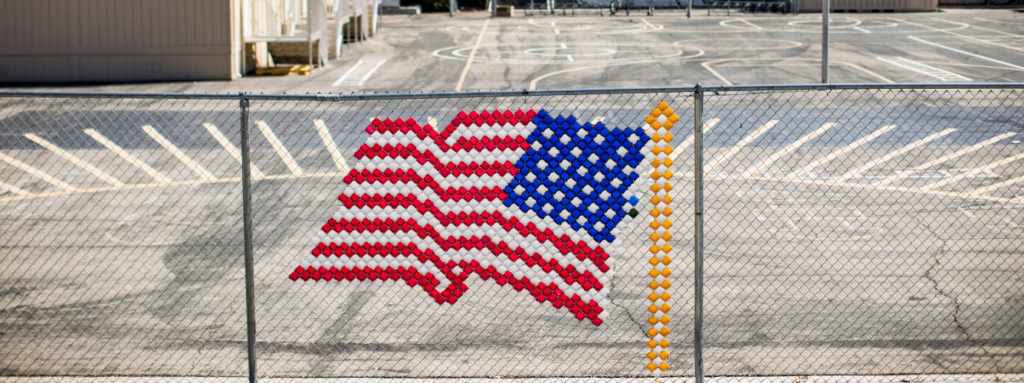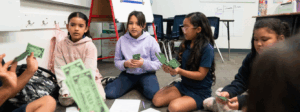In an election year, it can sometimes seem impossible to bridge the political differences that divide us as a nation. But when it comes to education policy, our young people have no time to waste. The Aspen Institute’s recent report, Crossing the Partisan Divide in Education Policy, offers a welcome sense of hope and optimism—along with strategies to guide advocates, policymakers, and education leaders who are eager to make meaningful change in education despite the challenges.
I sat down with the authors of this inspiring report, Dr. Lorén Cox, Policy Director at Aspen’s Education & Society Program and Karen Nussle, former President of Conservative Leaders for Education, to hear their perspectives on how to foster cross-partisan collaboration to improve PK-12 education for young people. Our conversation below was edited for length and clarity.
Your optimism about what is possible for education policy really resonates with us at TNTP. What prompted you to write this report?
Lorén Cox: For folks who are doing the work, day in and day out, it sometimes feels like everyone disagrees on everything. We argue about issues that do not center kids and their needs. But the truth is, there are a lot of people who are doing good things to move education policy forward, so we wanted to uplift that point, explore how they’re doing it, and build on what’s working.
Karen Nussle: In the paper, we found some great examples of real things happening in surprising places with surprising partners. It gives me a sense of optimism to see things happening outside of people’s traditional notions of who should be for what.
It’s exhausting to sit around and complain about how horrible things are. When we focus on what’s possible, it lifts us out of our doldrums. At the same time, we can’t be naive about the political environment we have versus the one we wish we had. We have to learn how to navigate the current environment and find ways to still be successful within it.
Can you unpack some of the values discussed in the paper that resonate strongly with both sides of the aisle, particularly in today’s climate?
Nussle: At the end of the day, all of these politicians are parents or grandparents, or they have kids in their lives who they care about. They want education to be high-quality, and they want it to be the best it can be for every kid. I think that’s true across the board. They may disagree with how that’s delivered and who’s in the primary decision-making role. But they want the education system to be the best in the world for our kids. We all want that.
Cox: If you look at the examples from the paper, people recognize when their community has a problem—sometimes it’s at the state level, and sometimes it’s even more local than that. But they recognize challenges that are impacting their kids and come together to fix them, so that they have better prospects moving forward. And sometimes, like Karen said, they have different ideas on how to fix them. But I think that’s the thread that we can pull through: ultimately, they are willing to figure out what can work so that students have access to what they deserve.
How can advocates and policymakers cut through the noise and remain focused on the needs of students?
Cox: One thing that’s important from where I sit is adults holding one another accountable. It doesn’t matter how much I dislike someone or their opinion or even what that person may be doing on another policy issue. As education advocates, we must recognize that, no matter how we are feeling about it in that moment, we have an obligation to focus on what would be positive for kids.
Nussle: I like to say just because your cause is righteous doesn’t mean you win. We hate all of the fighting and all of the partisanship, but if we’re trying to shape policy that helps kids, we have to figure out how to get a policy across the finish line. So, we can’t just say it’s the right thing to do, and the people who are against it are just bad people. That’s not the way our system works. You have to have the votes, and you have to have something that appeals to the people who are voting
How are particularly effective leaders framing issues for their bases, especially in the context of science of reading or similar programs? How easy is it to communicate, and how critical is broad appeal?
Nussle: An important stylistic thing for leaders is not to entrench themselves in a position too early in the process. They have to leave themselves an ability to move, particularly when it comes to communicating to their base. In terms of substance, I think the ability to listen and build coalitions is critical, even within one’s own party. We’re finding that leaders are surprisingly more concerned and frustrated with the fact that they can’t seem to communicate with the people who wear the same jersey as them, let alone the people who don’t.
Cox: One thing that could serve our leaders well is to know their issue well enough to communicate it simply: make simple statements that folks can connect with, but also be able to explain how you got there and understand the nuances.
On content, we’re seeing people get a lot of movement across the aisle talking about the importance of education beyond academic mastery. And to be very clear, I think academic mastery is important, but I think there are a lot of people frustrated with the fact that schools are not preparing students beyond those things. Leaders need to connect the problem or the policy with the longer-term outcomes for not just students, but their families and the community, too.
We at TNTP couldn’t agree more. While academics are an essential foundation for young people, they are not enough to get them to economic and social mobility. What bright spots and possibilities for cross-partisan work do you see related to giving young people access to opportunities beyond academics?
Cox: Whether they’re Democrats or Republicans, almost everyone’s child will have to work someday. So, I think being able to communicate to folks that education is about making sure that kids are prepared for whatever is next is key. It’s something that’s unifying—across party, across class, across race—that people can get behind. Right now, we have pretty good data that the system is not meeting the mark in preparing students for what’s next. Higher education is saying that students are not coming to them prepared. The business community is not getting the employees that they need. The military is now having to do extra work with recruits before they can enlist them. And so, if everyone on that end of the spectrum is saying something is wrong, there’s an agreement about a failure on the system’s behalf.
A deep commitment to civic education, in particular, stood out to us as a key element of the report. What opportunities do you see in a cross-partisan commitment to preparing young people for their roles as future leaders?
Cox: I think we have this shared narrative that Gen Zers and young people are not “in it” in the way that older adults are. But Murmuration’s report looked at the voting rates of each generation during the ages of 18-24, and Gen Z did better than all the other generation groups! In terms of optimism around civic participation, we have a willing group of young people that want to focus on important issues. And I think being responsive to them and what they want to be prepared for in the future is a really good place to start.
Nussle: I think this is another example of each side being motivated somewhat differently but toward the same goal. The bottom line is we all think civic engagement is really important if we’re going to have a good democracy and a good country and if we’re going to keep this American experiment moving forward in a healthy way.








